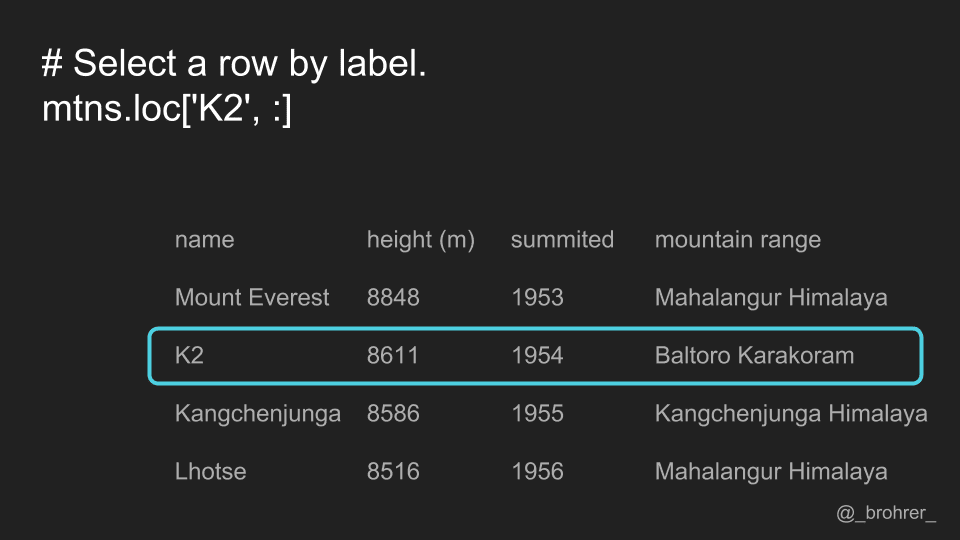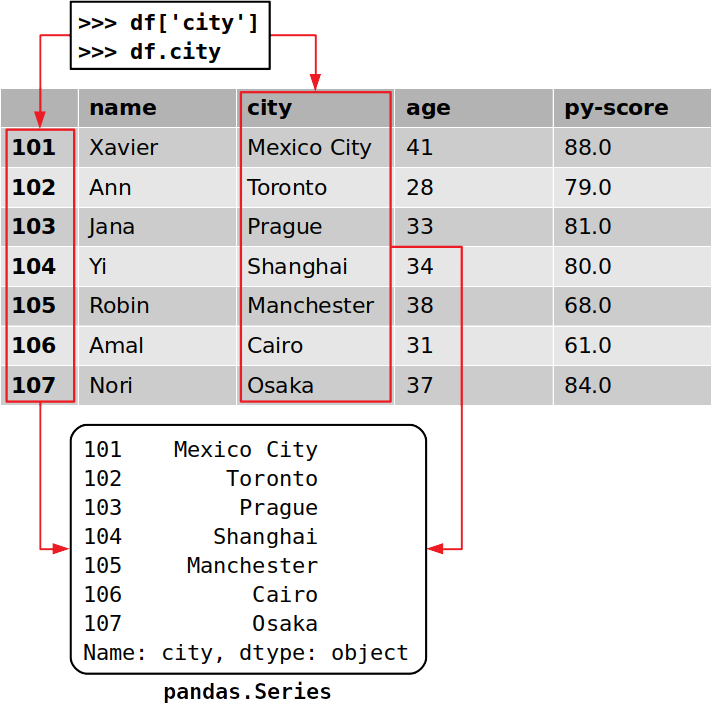39 pandas series get labels
Python | Pandas Series.get() - GeeksforGeeks Now we will use Series.get () function to return the value for the passed index label in the given series object. # return the value corresponding to # the passe index label result = sr.get (key = '2011-03-31') # Print the result print(result) Output : Pandas Get Column Names from DataFrame - Spark by {Examples} You can get the Pandas DataFrame Column Names by using DataFrame.columns.values method and to get it as a list use tolist(). Each column in a Pandas DataFrame has a label/name that specifies what type of value it holds/represents. Getting a column names is useful when you wanted to access all columns by name programmatically or manipulate the ...
Pandas Series: idxmax() function - w3resource Get the row label of the maximum value in Pandas series . The idxmax() function is used to get the row label of the maximum value. If multiple values equal the maximum, the first row label with that value is returned. Syntax: Series.idxmax(self, axis=0, skipna=True, *args, **kwargs) Parameters:

Pandas series get labels
How to get the names (titles or labels) of a pandas data ... Examples of how to get the names (titles or labels) of a pandas data frame in python. Summary. Get the row names of a pandas data frame; Get the row names of a pandas data frame (Exemple 1) ... Get the row names of a pandas data frame (Exemple 2) Another example using the csv file train.csv ... pandas.Series.loc — pandas 1.4.2 documentation pandas.Series.loc ¶ property Series.loc ¶ Access a group of rows and columns by label (s) or a boolean array. .loc [] is primarily label based, but may also be used with a boolean array. Allowed inputs are: A single label, e.g. 5 or 'a', (note that 5 is interpreted as a label of the index, and never as an integer position along the index). 7 Reindexing and altering labels — Pandas Doc 7 Reindexing and altering labels. reindex() is the fundamental data alignment method in pandas. It is used to implement nearly all other features relying on label-alignment functionality. To reindex means to conform the data to match a given set of labels along a particular axis. This accomplishes several things:
Pandas series get labels. Python Pandas Series - Python Examples To create Pandas Series in Python, pass a list of values to the Series () class. Pandas will create a default integer index. In the following example, we will create a pandas Series with integers. Python Program import numpy as np import pandas as pd s = pd.Series([1, 3, 5, 12, 6, 8]) print(s) Run Output 0 1 1 3 2 5 3 12 4 6 5 8 dtype: int64 Python | Pandas Series.keys() - GeeksforGeeks Example #1: Use Series.keys () function to return the index labels of the given series object. # importing pandas as pd import pandas as pd # Creating the Series sr = pd.Series ( [10, 25, 3, 25, 24, 6]) # Create the Index index_ = ['Coca Cola', 'Sprite', 'Coke', 'Fanta', 'Dew', 'ThumbsUp'] # set the index sr.index = index_ # Print the series Modifying a Series in-place | Learning pandas - Second Edition Rows can be removed from a Series by passing their index labels to the del () function. The following demonstrates removal of the row with the index label 'a': To add and remove items out of place, you use pd.concat () to add and remove using a Boolean selection. An important thing to keep... Unlock full access Continue reading with a subscription › python-pandas-series-isinPython | Pandas Series.isin() - GeeksforGeeks Oct 01, 2021 · Pandas series is a One-dimensional ndarray with axis labels. The labels need not be unique but must be a hashable type. The object supports both integer- and label-based indexing and provides a host of methods for performing operations involving the index. Pandas Series.isin() function check whether values are contained in Series. It returns a ...
Convert Pandas Series to a List - Data Science Parichay There are a number of ways to get a list from a pandas series. You can use the tolist () function associated with the pandas series or pass the series to the python built-in list () function. The following is the syntax to use the above functions: # using tolist () ls = s.tolist() # using list () ls = list(s) Pandas Series Attributes - AlphaCodingSkills Series attributes reflect information that is intrinsic to the series. Accessing a series through its attributes allows us to get the intrinsic properties of the series. Most commonly used attributes are mentioned below: Function. Description. Series.dtype. Return the dtype object of the underlying data. Series.empty. python - Pandas: Get label for value in Series Object ... Pandas: Get label for value in Series Object. Ask Question Asked 9 years ago. Modified 9 years ago. Viewed 22k times 18 2. How is it possible to retrieve the labe of a particular value in a pandas Series object: For example: labels = ['a', 'b', 'c', 'd', 'e'] s = Series (arange(5) * 4 , labels) ... Pandas Series - W3Schools Create a simple Pandas Series from a list: import pandas as pd a = [1, 7, 2] myvar = pd.Series (a) print(myvar) Try it Yourself » Labels If nothing else is specified, the values are labeled with their index number. First value has index 0, second value has index 1 etc. This label can be used to access a specified value. Example
pandas.Series.loc — pandas 0.25.0.dev0+752.g49f33f0d ... Access a group of rows and columns by label (s) or a boolean array. .loc [] is primarily label based, but may also be used with a boolean array. Allowed inputs are: A single label, e.g. 5 or 'a', (note that 5 is interpreted as a label of the index, and never as an integer position along the index). A list or array of labels, e.g. ['a', 'b', 'c']. How to Change Column Labels in Pandas DataFrame? - Python Pandas DataFrame- Rename Column Labels. To change or rename the column labels of a DataFrame in pandas, just assign the new column labels (array) to the dataframe column names. In this tutorial, we shall learn how to rename column labels of a Pandas DataFrame, with the help of well illustrated example programs. Labeling Data with Pandas. Introduction to Data Labeling ... We can use the Pandas '.loc []' method to assign ternary labels to the data, which would segment the data into three groups. The label of '0' will be assigned to values (4-7), '1' will be assigned to values (7-9), and '2' will be assigned to values (9-16): How to get the index and values of series in Pandas? A pandas Series holds labeled data, by using these labels we can access series elements and we can do manipulations on our data. However, in some situations, we need to get all labels and values separately. Labels can be called indexes and data present in a series called values. If you want to get labels and values individually.
Duplicate Labels — pandas 1.4.2 documentation That said, you may want to avoid introducing duplicates as part of a data processing pipeline (from methods like pandas.concat(), rename(), etc.). Both Series and DataFrame disallow duplicate labels by calling .set_flags(allows_duplicate_labels=False). (the default is to allow them). If there are duplicate labels, an exception will be raised.
Pandas Lesson 1: Series - Practical Data Science An index is a set of labels for each observation in a Series. If you don't specify an index when you create a Series, pandas will just create a default index that just labels each row with its initial row number, but you can specify an index if you want.
Python | Pandas Series - Tutorialspoint.dev Python | Pandas Series. Pandas Series is a one-dimensional labeled array capable of holding data of any type (integer, string, float, python objects, etc.). The axis labels are collectively called index. Pandas Series is nothing but a column in an excel sheet. Labels need not be unique but must be a hashable type.
Python Pandas - Series - Tutorialspoint A Series is like a fixed-size dict in that you can get and set values by index label. Example 1 Retrieve a single element using index label value. Live Demo import pandas as pd s = pd.Series( [1,2,3,4,5],index = ['a','b','c','d','e']) #retrieve a single element print s['a'] Its output is as follows − 1 Example 2
how to Access the elements of a Series in python - pandas ... Accessing data from series with Labels or index: A Series is like a fixed-size dictionary in that you can get and set values by index label. Retrieve a single element using index label: # create a series import pandas as pd import numpy as np data = np.array(['a','b','c','d','e','f']) s = pd.Series(data,index=[100,101,102,103,104,105]) print s ...
pandas.Series — pandas 1.4.2 documentation pandas.Series — pandas 1.4.2 documentation pandas.Series ¶ class pandas.Series(data=None, index=None, dtype=None, name=None, copy=False, fastpath=False) [source] ¶ One-dimensional ndarray with axis labels (including time series). Labels need not be unique but must be a hashable type.
realpython.com › pandas-dataframeThe Pandas DataFrame: Make Working With Data Delightful It’s important to notice that you’ve extracted both the data and the corresponding row labels: Each column of a Pandas DataFrame is an instance of pandas.Series, a structure that holds one-dimensional data and their labels. You can get a single item of a Series object the same way you would with a dictionary, by using its label as a key: >>>
Python Tryit Editor v1.0 - W3Schools Run Get your own website Result Size: 497 x 414. ... x . import pandas as pd a = [1, 7, 2] myvar = pd. Series (a, index = ["x", "y", "z"]) print (myvar) x 1 y 7 z 2 dtype: int64 ...
python - How to print x-axes labels in pandas.Series.plot ... For that purpose, I use the below and get desired output - df.groupby ('owner_team').inc_subj.count ().plot.bar (ylim=0) Output - My concern is the x-axes labels are shown as numbers, which is the exactly values present. But, my desire is to see the names (string values) corresponding to those numbers.
Pandas Series: drop() function - w3resource Pandas Series: drop() function Last update on April 18 2022 10:49:37 (UTC/GMT +8 hours) Remove series with specified index labels. The drop() function is used to get series with specified index labels removed. Remove elements of a Series based on specifying the index labels. When using a multi-index, labels on different levels can be removed by ...
A Practical Introduction to Pandas Series | by B. Chen ... A practical introduction to Pandas Series (Image by Author using canva.com). DataFrame and Series are two core data structures in Pandas.DataFrame is a 2-dimensional labeled data with rows and columns. It is like a spreadsheet or SQL table. Series is a 1-dimensional labeled array. It is sort of like a more powerful version of the Python list.Understanding Series is very important, not only ...
pandas Tutorial => Select column by label Filtering columns (selecting "interesting", dropping unneeded, using RegEx, etc.) Get the first/last n rows of a dataframe. Mixed position and label based selection. Path Dependent Slicing. Select by position. Select column by label. Select distinct rows across dataframe. Slicing with labels. IO for Google BigQuery.
Pandas Select Rows by Index (Position/Label) - Spark by ... Use pandas.DataFrame.loc [] to Select Rows by Index Labels By using pandas.DataFrame.loc [] you can select rows by index names or labels.
Labeling your axes in pandas and matplotlib Specify axis labels with pandas. When you plot, you get back an ax element. It has a million and one methods, two of which are set_xlabel and set_ylabel. # Draw a graph with pandas and keep what's returned ax = df. plot (kind = 'scatter', x = 'GDP_per_capita', y = 'life_expectancy') # Set the x scale because otherwise it goes into weird negative numbers ax. set_xlim ((0, 70000)) # Set the x ...
7 Reindexing and altering labels — Pandas Doc 7 Reindexing and altering labels. reindex() is the fundamental data alignment method in pandas. It is used to implement nearly all other features relying on label-alignment functionality. To reindex means to conform the data to match a given set of labels along a particular axis. This accomplishes several things:
pandas.Series.loc — pandas 1.4.2 documentation pandas.Series.loc ¶ property Series.loc ¶ Access a group of rows and columns by label (s) or a boolean array. .loc [] is primarily label based, but may also be used with a boolean array. Allowed inputs are: A single label, e.g. 5 or 'a', (note that 5 is interpreted as a label of the index, and never as an integer position along the index).
How to get the names (titles or labels) of a pandas data ... Examples of how to get the names (titles or labels) of a pandas data frame in python. Summary. Get the row names of a pandas data frame; Get the row names of a pandas data frame (Exemple 1) ... Get the row names of a pandas data frame (Exemple 2) Another example using the csv file train.csv ...













Post a Comment for "39 pandas series get labels"